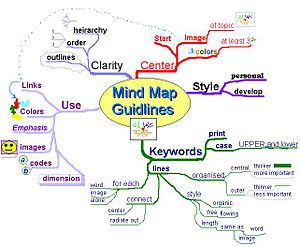 Image via Wikipedia
Image via WikipediaIntroduction:
Mind map is a trade mark of the Buzan Organistion, ltd. In the UK and the USA. And it was popularized by Tony Buzan. Mind map can be used by not only students but by people in any stream. This will be helpful to remember the things that we have to accomplish. We can even use this method while going for presentation for making notes on key words instead of using too much of papers.
Mind map:
A mind map is a diagram used to represent words, ideas, tasks, or other items linked to and arranged radially around a central key word or idea. Mind maps are used to generate, visualize, structure, and classify ideas, and as an aid in study, organization, problem solving, decision making and writing.
The elements of a given mind map are arranged intuitively according to the importance of the concepts, and are classified into groupings, branches, or areas, with the goal of representing semantic or other connections between portions of information.
Uses of mind map:
Mind Mapping is a useful technique that improves the way you take notes, and supports and enhances your creative problem solving.
By using Mind Maps, you can quickly identify and understand the structure of a subject, and the way that pieces of information fit together, as well as recording the raw facts contained in normal notes.
More than this, Mind Maps encourage creative problem solving, and they hold information in a format that your mind finds easy to remember and quick to review.
Mind Maps abandon the list format of conventional note taking. They do this in favor of a two-dimensional structure. As such, a good Mind Map shows the 'shape' of the subject, the relative importance of individual points, and the way in which facts relate to one another.
Mind Maps are more compact than conventional notes, often taking up one side of paper. This helps you to make associations easily. And if you find out more information after you have drawn the main Mind Map, then you can easily add it in.
Other uses:
- Summarizing information
- Consolidating information from different research sources
- Thinking through complex problems
- Presenting information in a format that shows the overall structure of your subject.
- They are very quick to review as you can often refresh information in your mind just by glancing at one.
- They can be effective mnemonics: Remembering the shape and structure of a Mind Map can give you the cues you need to remember the information within it.
- They engage much more of your brain in the process of assimilating and connecting facts, compared with conventional notes.
Guidelines to draw mind map:
- Write the title of the subject you're exploring in the center of the page, and draw a circle around it.
- As you come across major subdivisions or subheadings of the topic draw lines out from this circle. Label these lines with these subdivisions or subheadings as lines.
- As you "burrow" into the subject and uncover another level of information i.e., further subheadings, or individual facts belonging to the subheadings above, draw these as lines linked to the subheading lines.
- Finally, for individual facts or ideas, draw lines out from the appropriate heading line and label them.
Improving Mind Maps:
The following suggestions may help to increase its effectiveness:
- Use single words or phrases for information.
- Use color to separate different ideas.
- Use symbols and images.
- Using cross-linkages.
Conclusion:
Mind Mapping is an extremely effective method of taking notes. Mind Maps show not only facts, but also the overall structure of a subject and the relative importance of individual parts of it. They help you to associate ideas and make connections that you might not otherwise make.
So I suggest everyone to use this mind map technique to enhance their creativity in problem solving and decision making.

No comments:
Post a Comment